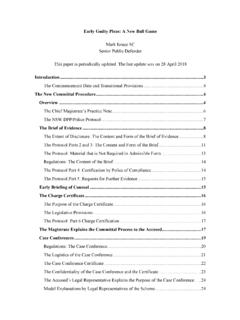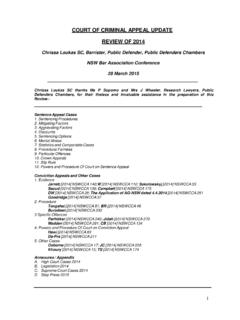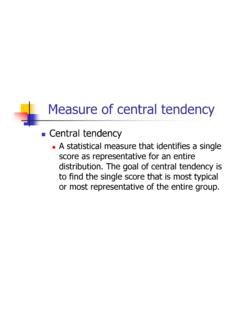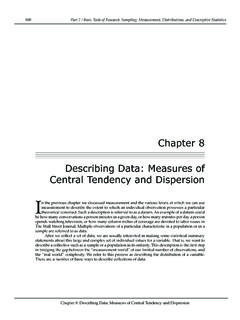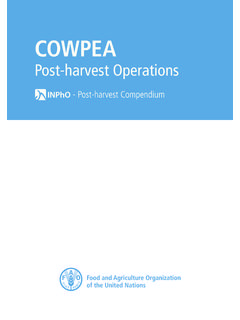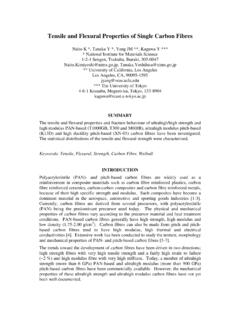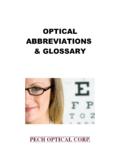Transcription of Tendency, Coincidence & Joint Trials
1 tendency , Coincidence & Joint Trials 2018 Public Defenders Conference Tim Gartelmann SC DCJ Carly Berrigan LLB(Hons) 17th March 2018 1 TABLE OF CONTENTS _____ INTRODUCTION 2 tendency 3 Overview 3 Evidence Act 1995 provisions 4 Notice 5 Section 97 determination 5 Significant probative value 5 Considerations 7 Section 101 determination 15 Prejudicial effect 15 Directions 17 Standard of proof 18 Anti- tendency 18 Coincidence 20 Overview 20 Evidence Act 1995 provisions 21 Notice 22 Section 98(1) determination 23 Significant probative value 23 Considerations 27 Section 101 determination 29 Prejudicial effect 29 Directions 30 Standard of proof 30 Concoction & contamination 30 Joint Trials 31 Criminal Procedure Act 1986 provisions 31 General principles 31 2 INTRODUCTION [1] tendency evidence and Coincidence evidence are among the more complicated and controversial areas of evidence law in criminal cases. [2] The issues that may arise in connection with tendency and Coincidence evidence are many and varied.
2 An examination of the full range of issues is beyond the scope of this paper. This paper seeks rather to address the central elements of the tests for admissibility and use of tendency and Coincidence evidence. [3] The High Court in IMM v The Queen (2016) 257 CLR 300 and Hughes v The Queen (2017) 92 ALJR 52 determined a number of important questions relating to the tests for admissibility and use of tendency and Coincidence evidence. This paper therefore extracts a number of statements of principle in the judgments in these cases. [4] An appreciation of the processes of reasoning underlying tendency evidence and Coincidence evidence is necessary for a sound understanding of the operation of the tests for their admissibility and use. This paper extracts a number of statements of principle from decisions of intermediate appellate courts regarding these processes of reasoning. [5] Some particular issues frequently arise in connection with questions of admissibility and use of tendency evidence and Coincidence evidence.
3 This paper attempts to summarise the ways in which appellate courts have approached some of the more commonly arising issues. [6] Finally, decisions regarding admissibility and use of tendency and Coincidence evidence often have ramifications for whether Trials of multiple counts will be Joint or separate. This paper briefly addresses when Joint or separate Trials of multiple counts may be appropriate following determinations regarding the admissibility and use of tendency and Coincidence evidence. 3 tendency Overview [7] Evidence known as tendency evidence under the Evidence Act 1995 was known as propensity evidence at common law. [8] The provisions of the Act are the primary source in considering questions of admissibility of such evidence, rather than the pre-existing common law: see IMM at [35]. However, the reasoning process underlying use of tendency evidence under the Act is cognate with that underlying the use of propensity evidence at common law.
4 [9] The common law treated propensity evidence as a form of circumstantial evidence: see Pfennig v The Queen (1995) 182 CLR 461 at 482-3. [10] In Elomar v R; Hasan v R; Cheikho v R; Cheikho v R; Jamal v R [2014] NSWCCA 303; 316 ALR 206 at [359]-[360], the Court (Bathurst CJ; Hoeben CJ at CL; Simpson J) described the reasoning process underlying the admission of tendency evidence as follows: tendency evidence is evidence that provides the foundation for an inference. The inference is that, because the person had the relevant tendency , it is more likely that he or she acted in the way asserted by the tendering party, or had the state of mind asserted by the tendering party on an occasion the subject of the proceedings. tendency evidence is a stepping stone. It is indirect evidence. It allows for a form of syllogistic reasoning. The process of reasoning is: on an occasion or occasions other than an occasion in question in the proceedings, a person acted in a particular way; it can therefore be concluded or inferred that the person had a tendency to act in that way; by reason of that tendency , it can therefore be concluded or inferred that, on an occasion in question in the proceedings, the person acted in conformity with that tendency .
5 Alternatively: on an occasion or occasions other than on an occasion in question in the proceedings, a person had a particular state of mind; it can therefore be concluded or inferred that the person had a tendency to have that state of mind; by reason of that tendency , it can therefore be concluded or inferred that, on an occasion in question in the proceedings, the person's state of mind conformed with that tendency . tendency evidence is a means of proving, by a process of deduction, that a person acted in a particular way, or had a particular state of mind, on a relevant 4 occasion, when there is no, or inadequate, direct evidence of that conduct or that state of mind on that occasion. [11] In Hughes at [16], the majority (Kiefel CJ, Bell, Keane and Edelman JJ) summarised the reasoning process as follows: The trier of fact reasons from satisfaction that a person has a tendency to have a particular state of mind or to act in a particular way to the likelihood that the person had the particular state of mind or acted in a particular way on the occasion in issue.
6 [12] Gageler J (in the minority) summarised it as follows (at [70]-[71]): Applied to evidence of past conduct, tendency reasoning is no more sophisticated than: he did it before; he has a propensity to do this sort of thing; the likelihood is that he did it again on the occasion in issue. tendency reasoning, as courts have long recognised, is not deductive logic. It is a form of inferential or inductive [13] Authorities dealing with tendency evidence under the Act thus treat the underlying reasoning process as a form of inferential reasoning. Evidence Act 1995 provisions [14] The Dictionary to the Act defines tendency evidence as evidence of a kind referred to in section 97(1) that a party seeks to have adduced for the purpose referred to in that subsection. [15] The purpose for which the evidence is tendered therefore defines it as tendency evidence: David L'Estrange v The Queen [2011] NSWCCA 89; 214 A Crim R 9 at [59]; CA v R [2017] NSWCCA 324 at [81].
7 [16] Accordingly, evidence that is tendered for a non- tendency purpose (for example, as context or relationship evidence) but which could also be used as tendency evidence, need not satisfy the conditions for admissibility of tendency evidence. [17] Section 95 of the Act provides that: 1) Evidence that under this Part is not admissible to prove a particular matter must not be used to prove that matter even if it is relevant for another purpose. 2) Evidence that under this Part cannot be used against a party to prove a particular matter must not be used against the party to prove that matter even if it is relevant for another purpose. [18] Section 97(1) of the Act provides that: Evidence of the character, reputation or conduct of a person, or a tendency that a person has or had, is not admissible to prove that a person has or had a tendency (whether because of the person s character or otherwise) to act in a particular way, or to have a particular state of mind unless: 5 a) the party seeking to adduce the evidence gave reasonable notice in writing to each other party of the party s intention to adduce the evidence, and b) the court thinks that the evidence will, either by itself or having regard to other evidence adduced or to be adduced by the party seeking to adduce the evidence, have significant probative value.
8 [19] Section 99 of the Act provides that: Notices given under section 97 or 98 are to be given in accordance with any regulations or rules of court made for the purposes of this section. [20] Section 101(2) of the Act provides that: tendency evidence about a defendant .. that is adduced by the prosecution cannot be used against the defendant unless the probative value of the evidence substantially outweighs any prejudicial effect it may have on the defendant. Notice [21] Sections 97(1)(a), 98(1)(a), 99 and 100 of the Act create a novel system requiring notice : R v Ellis (2003) 58 NSWLR 700; 144 A Crim R 1, [2003] NSWCCA 319 at [80]. [22] The purpose of the requirement for notice pursuant to s 97(1)(a) is not simply to ensure the other party is informed of the intention to adduce tendency evidence but to ensure the asserted tendency is properly articulated and the evidence proposed to be adduced in support of it is clearly identified. [23] In Hughes at [105], Gageler J described the function of a tendency notice as follows: Making the evaluative judgment required of a court in the implementation of the tendency rule is facilitated by the procedural requirement that a party must ordinarily give notice of an intention to seek to adduce tendency evidence.
9 The utility of the tendency notice goes beyond providing procedural fairness to other parties. The tendency notice provides the court, at the critical time of assessing the admissibility of tendency evidence, with a statement of the particular tendency which the party seeking to adduce the tendency evidence seeks to prove by it. The importance of explicitly identifying in the notice the particular tendency that is asserted, as Howie AJ put it in Bryant v R, should be obvious: how else is the court going to be able to make a rational decision about the probative value of the evidence . By identifying the particular tendency that the evidence is asserted to prove, the notice allows the court to evaluate the strength of the connection between the evidence and the tendency and the strength of the connection between the tendency and the fact in issue. Section 97 determination Significant probative value [24] The Dictionary to the Act defines the probative value of evidence as the extent to which the evidence could rationally affect the assessment of the probability of the existence of facts in issue in the proceedings.
10 6 [25] Significant probative value has been interpreted as connoting something more than mere relevance but something less than a substantial degree of relevance : R v Lockyer (1996) 89 A Crim R 457 at 459; DSJ v The Queen [2012] NSWCCA 9; 84 NSWLR 758 at [58] and [60]. [26] The majority in Hughes adopted (at [40]) the following description of significant probative value from Campbell JA s judgment in R v Ford [2009] NSWCCA 306; (2009) 201 A Crim R 451 at [125]: [T]he disputed evidence should make more likely, to a significant extent, the facts that make up the elements of the offence charged. [27] In IMM at [103], Gageler J observed that: To the extent that similes can help elucidate the statutory measure of significant , the capacity of the evidence to contribute to the proof or disproof of the existence of the fact in issue does not need to be substantial but does need to be important or of consequence . [28] The determination whether probative value is significant is an evaluative judgment about which minds may differ, as the majority in Hughes noted (at [16]): [T]he open-textured nature of an enquiry into whether the court thinks that the probative value of the evidence is significant means it is inevitable that reasonable minds might reach different conclusions.



